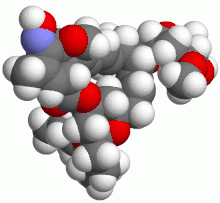Selamectin
 |
|
 |
|
| Clinical data | |
|---|---|
| Trade names | Revolution, Stronghold |
| AHFS/Drugs.com | International Drug Names |
| Routes of administration |
Topical |
| ATCvet code | |
| Identifiers | |
| CAS Number | |
| PubChem CID | |
| ChemSpider | |
| UNII | |
| ChEMBL | |
| Chemical and physical data | |
| Formula | C43H63NO11 |
| Molar mass | 769.96 g/mol |
| 3D model (Jmol) | |
|
|
|
|
|
|
|
Selamectin (trade names Revolution, Stronghold) is a topical parasiticide and anthelminthic used on dogs and cats, distributed by Zoetis, a former Pfizer subsidiary. It treats and prevents infections of heartworms, fleas, ear mites, sarcoptic mange (scabies), and certain types of ticks in dogs, and prevents heartworms, fleas, ear mites, hookworms, and roundworms in cats. It also removes 2 types of lungworm in cats (Aelurostrongylus abstrusus, Eucoleus aerophilus) and one type of lungworm in dogs (Eucoleus aerophilus). It is structurally related to ivermectin and milbemycin. Selamectin is not approved for human use.
The drug is applied topically. It is waterfast, and does not lose its effectiveness with bathing. It is packaged according to its varying dosage sizes, and is applied once monthly.
Selamectin disables parasites by activating glutamate-gated chloride channels at muscle synapses. Selamectin activates the chloride channel without desensitization, allowing chloride ions to enter the nerve cells and causing neuromuscular paralysis, impaired muscular contraction, and eventual death.
The substance fights both internal and surface parasitic infection. Absorbed into the body through the skin and hair follicles, it travels through the bloodstream, intestines, and sebaceous glands; parasites ingest the drug when they feed on the animal's blood.
...
Wikipedia
